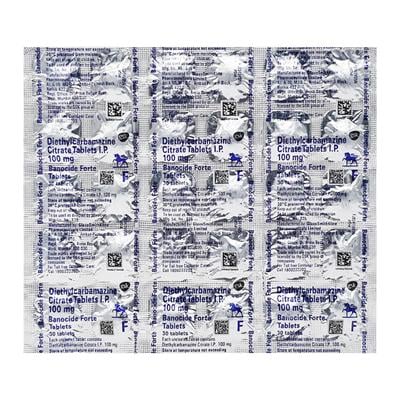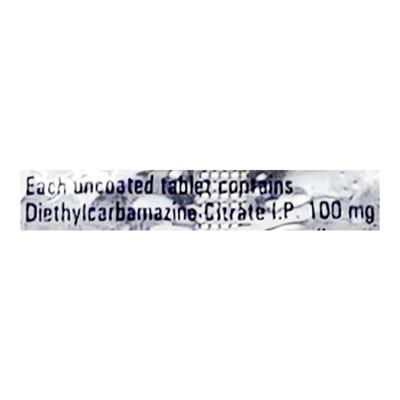

Netmeds First Membership
Quick Links
Introduction About BANOCIDE FORTE TABLET
BANOCIDE FORTE TABLET contains Diethylcarbamazine which belongs to the group of medicines called Anthelmintics. It is used to manage filarial infections, tropical eosinophilia and toxocariasis. It is also used to manage loiasis (eye worm infections).
Filariasis is an infectious tropical disease caused by any one of several thread-like parasitic roundworms.
BANOCIDE FORTE TABLET should be used with caution in patients with seizures and liver diseases. Contact your doctor before taking it.
BANOCIDE FORTE TABLET is not recommended for use in patients with kidney or heart disease. Contact your doctor before taking it.
BANOCIDE FORTE TABLET is generally not recommended for use in pregnant women. Contact your doctor before taking it. BANOCIDE FORTE TABLET is generally not recommended for use in breastfeeding women as it is not known whether it may pass through the breast milk. Contact your doctor before taking it.
There is only limited information available on the use of BANOCIDE FORTE TABLET in geriatric patients. Consult your doctor before taking it.
The most common side effects of taking BANOCIDE FORTE TABLET are nausea and vomiting. Contact your doctor if your symptoms got worse.
Uses Of BANOCIDE FORTE TABLET
Used to manage and prevent:
- filarial infections
- tropical eosinophilia
- toxocariasis
- loiasis (eye worm infection)
How BANOCIDE FORTE TABLET Works
BANOCIDE FORTE TABLET functions by destroying the infection-causing parasites and managing their future growth.
How to use BANOCIDE FORTE TABLET
Take BANOCIDE FORTE TABLET as advised by your physician. Swallow the medicine. Do not crush or chew the medicine. Based on your age, body weight and medical condition, your doctor will choose the appropriate dose and duration for you.
Side Effects Of BANOCIDE FORTE TABLET
Common
- nausea and vomiting
- headache
- lassitude (lack of energy)
How To Manage Side Effects
Nausea and Vomiting:
Take the medicine, with or just after a meal. Stick to simple meals. Avoid eating oily or spicy food. Contact your doctor if the symptoms did not improve.
Headache:
Try to take rest and don’t involve yourself in exertive activities. Apply a pain-relieving balm to your forehead. If the headache does not improve, consult with your doctor.
Warning & Precautions
Pregnancy
BANOCIDE FORTE TABLET is generally not recommended for use in pregnant women. Contact your doctor before taking it.
Breastfeeding
BANOCIDE FORTE TABLET is generally not recommended for use in breastfeeding women as it is not known whether it may pass through the breast milk. Contact your doctor before taking it.
Driving and Using Machines
Do not drive or operate any machines if you feel drowsy after taking BANOCIDE FORTE TABLET.
Kidney
BANOCIDE FORTE TABLET is not recommended for use in patients with kidney disease. Contact your doctor before taking it.
Liver
There is limited information available on the use of BANOCIDE FORTE TABLET in patients with liver disease. Consult your doctor before taking it.
Allergy
Do not take BANOCIDE FORTE TABLET if you are allergic to Diethylcarbamazine or intolerance to lactose or other ingredients of the medicine.
Heart Disease
BANOCIDE FORTE TABLET is not recommended for use in patients with heart diseases. Contact your doctor before taking it.
Others
BANOCIDE FORTE TABLET is not recommended if you have:
- serious eye damage due to onchocerciasis (parasitic eye disease)
- rare hereditary problems such as galactose intolerance, Lapp lactase deficiency and glucose-galactose malabsorption
Before taking BANOCIDE FORTE TABLET, inform your doctor if you have:
- epilepsy
- other acute concomitant diseases
Use in pediatrics:
Your doctor will give the right dose of BANOCIDE FORTE TABLET depending on your child’s age, body weight and disease condition. Contact your doctor before taking it.
Use in geriatrics:
There is only limited information available on the use of BANOCIDE FORTE TABLET in elderly patients. Consult your doctor before taking it.
Interactions
A. Drug - Drug interaction:
Tell your doctor if you are taking or have recently taken any other medicines, including medicines obtained without a prescription, vitamin supplements or herbal products.
Overdosage:
If you or anyone else accidentally takes too much of BANOCIDE FORTE TABLET, consult your doctor immediately or visit the nearby hospital. Symptoms of overdose are headache, dizziness, drowsiness, nausea, vomiting and, in serious cases, it may cause convulsions.
Synopsis
| Drug | : | Diethylcarbamazine |
| Pharmacological Category | : | Anthelmintics |
| Therapeutic Indication | : | Manage parasitic infections |
| Dosage Forms | : |
Tablet, Syrup |
More Information
- Keep BANOCIDE FORTE TABLET out of the sight and reach of children
- Store BANOCIDE FORTE TABLET below 30°C
FAQs About BANOCIDE FORTE TABLET
What type of drug is BANOCIDE FORTE TABLET?
BANOCIDE FORTE TABLET contains Diethylcarbamazine which belongs to the group of medicines called Anthelmintics.
Can I use BANOCIDE FORTE TABLET in children?
Yes, BANOCIDE FORTE TABLET should be used with caution in children, your doctor will give the right dose depending on your child’s age, body weight and disease condition. Contact your doctor before taking it.
What are the side effects of taking BANOCIDE FORTE TABLET?
The most common side effects of taking BANOCIDE FORTE TABLET are nausea and vomiting. Contact your doctor if your symptoms got worse.
Can I use BANOCIDE FORTE TABLET in pregnancy?
No. BANOCIDE FORTE TABLET is generally not recommended for use in pregnant women. Contact your doctor before taking it.
Is BANOCIDE FORTE TABLET safe?
BANOCIDE FORTE TABLET is safe if used in the dose and duration advised by your doctor. Take it exactly as directed and do not skip any dose.
Can the use of BANOCIDE FORTE TABLET cause drowsiness?
Yes, BANOCIDE FORTE TABLET may cause drowsiness. Avoid driving, operating on machinery, working at heights or participating in potentially dangerous activities, especially during the initial days of your management. However, if your condition does not improve, consult your doctor.
References
1. H. P. Rang, J.M. Ritter, R. J. Flower, G. Henderson. Anthelmintic drugs. Rang and Dale's Pharmacology. Eighth edition. 2014. Page – 674.
2. KD. Tripathi. Anthelmintic Drugs. Essentials of medical pharmacology. Seventh edition. 2013. Page – 853.
3. Padmaja Udayakumar. Anthelmintics and Drugs used in Scabies and Pediculosis. Pharmacology for Pharmacy Students. 2018. 631-632.
4. Whalen, K., Finkel, R., & Panavelil, T. A. Anthelmintic drugs. Lippincott illustrated reviews: Pharmacology. Sixth edition. 2015. Page – 562.
5. Ottesen EA. Description, mechanisms and control of reactions to treatment in the human filariases. Ciba Found Symp. 1987. [Accessed 18 July 2022] https://pubmed.ncbi.nlm.nih.gov/3297558/
6. OE Orisakwe, NA Ilondu, OJ Afonne, SI Ofoefule, CN Orish. Acceleration of body clearance of diethylcarbamazine by oral activated charcoal. Pharmacological Research. Aug 2000. [Accessed on 18th July 2022] https://pubmed.ncbi.nlm.nih.gov/10887047/
7. GlaxoSmithKline Pharmaceuticals Limited. Diethylcarbamazine Citrate. [Revised in June 2021] [Accessed on 18th July 2022] https://india-pharma.gsk.com/media/6339/banocide-and-banocide-forte.pdf
8. Sanofi Aventis France. Diethylcarbamazine. [Revised in October 2016] [Accessed on 18th July 2022] https://extranet.who.int/pqweb/sites/default/files/NT001Part3v1.pdf
9. Pfizer Ltd. Diethylcarbamazine. [Revised in 2018] [Accessed on 18th July 2022] https://labeling.pfizer.com/ShowLabeling.aspx?id=14804
Useful Diagnostic Tests
- complete blood test
- peripheral smear count
- filarial antibody







